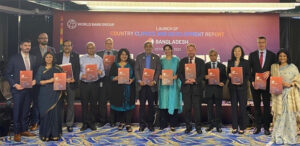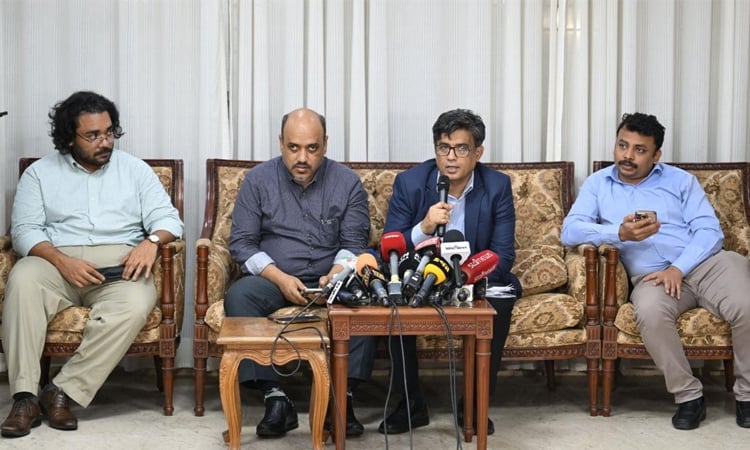 Mehrin Ahmed Mahbub: Despite significant gains in reducing the human toll from climate disasters, Bangladesh continues to face severe and increasing climate risks. Without urgent action, including further adaptation and resilience measures, the country’s strong growth potential could be in risk, according to the World Bank Group’s Country and Climate Development Report for Bangladesh released on Monday.
Mehrin Ahmed Mahbub: Despite significant gains in reducing the human toll from climate disasters, Bangladesh continues to face severe and increasing climate risks. Without urgent action, including further adaptation and resilience measures, the country’s strong growth potential could be in risk, according to the World Bank Group’s Country and Climate Development Report for Bangladesh released on Monday.
The report outlines priority actions and financing needs to help Bangladesh address the climate crisis. It recognizes Bangladesh’s successful experience with locally-led climate adaptation and recommends investments in infrastructure and services to strengthen climate resilience while supporting long-term growth. Actions focused on improved agriculture productivity, energy and transport efficiency can lower future emissions while improving air, soil, and water quality.
The report estimates that Bangladesh can raise up to $12.5 billion in additional financing in the medium-term for climate action. Financing options include budget prioritization, carbon taxation, external financing, and private investment.
Climate change will hit poor and vulnerable people the hardest. Average tropical cyclones cost Bangladesh about $1 billion annually. By 2050, a third of agricultural GDP could be lost and 13 million people could become internal climate migrants. In case of a severe flooding, GDP could fall by as much as 9 percent.
“Bangladesh has led the way in adaptation and disaster risk management. Over the past 50 years, it has reduced cyclone-related deaths 100-fold. Other countries can learn from this,” said Martin Raiser, World Bank Vice President for South Asia. “But with ever-increasing climate risks, further adaptation efforts are vital, and a low-carbon development path is critical to a resilient future for Bangladesh.”
At just 0.4 percent, Bangladesh’s current contribution to global greenhouse gas (GHG) emissions is not significant. But with its large population and fast economic growth, if the country follows a ‘business-as-usual’ development pathway, GHG emissions will increase substantially. Bangladesh also faces a high level of air pollution, which costs about 9 percent of GDP annually. Improved air quality standards across multiple sectors will improve health and increase climate resilience. The country’s 2021 Nationally Determined Contributions (NDCs) commit to reducing emissions by 21.8 percent by 2030. With strong implementation, technology development and uptake, and regional collaboration, Bangladesh can exceed these commitments.
“In the face of multiple severe risks from climate change, Bangladesh urgently needs to spur more private sector involvement not only to deliver the billions of dollars needed for climate action, but also to drive innovation and efficiency to benefit and protect the country’s people,” said John F. Gandolfo, IFC’s Acting Regional Vice President for Asia and the Pacific. “Increased private sector involvement in renewable energy and energy transmission, housing, transport, and climate smart agriculture is both necessary and possible, with concerted efforts to speed up needed reforms to overcome barriers to domestic and foreign investment and green the financial sector so more funding is available for green projects.”
The report highlights three priority areas for Bangladesh’s climate-resilient growth and development:
People-centric, climate-smart development: A development approach that considers regional variations in climate impacts and builds on Bangladesh’s experience of locally-led adaptation and small-scale solutions is vital. Investing in public services, nature-based solutions, and infrastructure in urban areas—including affordable housing, resilient transport connectivity, and water and waste management—will help cities prepare for an influx of climate migrants.
Delivering development benefits with decarbonization: Emissions from energy, transport, industry, and agriculture can be reduced at relatively low cost and yield significant co-benefits related to air pollution, health costs, and jobs. By implementing policies that abate both air pollution and emissions, Bangladesh can reduce deaths from air pollution by half or save nearly 1 million lives within 2030. Shifting industries to a more sustainable path will increase their global competitiveness. With rapid urbanization, income growth, and changing dietary patterns, opportunities exist for more efficient, low-carbon agriculture and food systems while increasing resilience and rural incomes.
Enabling environment and institutional realignment: With a stronger legislative and institutional capacity, Bangladesh can accelerate the implementation of existing policies and programs. Empowering local governments to plan and implement adaptation programs will be important. Addressing financial sector vulnerabilities will be critical together with policies to green the financial sector. Increased domestic and foreign private sector involvement, such as in climate-smart agriculture and renewable energy, is necessary.
Some parts of Bangladesh are more prone to climate change impacts. Hence, investments should be prioritized for climate hotspots such as in the Barind, Coastal zone, Haor area, and Hill Tracts, and the regions facing higher poverty rates and natural hazards: the western upazilas of Mymensingh, eastern upazilas of Rangpur, and southern parts of Khulna Division.
The report identifies high-impact interventions that are ready for implementation. This includes prioritizing and allocating financing for most urgent projects under the Bangladesh Delta Plan 2100, transforming food systems, implementing energy-efficient and circular economy solutions in ready-made garments and textile factories, setting resilient and energy efficient building standards, and mitigating emissions through tariff reforms and loss reduction. The Bangladesh Delta Plan 2100 and Mujib Climate Prosperity Plan recognize these priorities.
“Bangladesh has taken bold steps toward its goal to support global efforts for combating climate change,” said MIGA Executive Vice President, Hiroshi Matano. “The CCDR provides vital guidance for the country to continue its long-term strategy for energy security that is more responsive to climate issues.”
At the report launch, the World Bank awarded the winners of the IdeaBuzz Championship, a youth competition seeking climate-smart solutions for inclusive growth in Bangladesh. The competition had garnered huge interest, with participation from over 400 university students. The first, second, and third prizes were awarded to the students of the Islamic University of Technology, Bangladesh University of Engineering and Technology, and Institute of Business Administration, University of Dhaka respectively.
World Bank Group Country Climate and Development Reports: The World Bank Group’s Country Climate and Development Reports (CCDRs) are new core diagnostic reports that integrate climate change and development considerations. They will help countries prioritize the most impactful actions that can reduce greenhouse gas (GHG) emissions and boost adaptation, while delivering on broader development goals. CCDRs build on data and rigorous research and identify main pathways to reduce GHG emissions and climate vulnerabilities, including the costs and challenges as well as benefits and opportunities from doing so. The reports suggest concrete, priority actions to support the low-carbon, resilient transition. As public documents, CCDRs aim to inform governments, citizens, the private sector and development partners and enable engagements with the development and climate agenda. CCDRs will feed into other core Bank Group diagnostics, country engagements and operations, and help attract funding and direct financing for high-impact climate action.
Author: Mehrin Ahmed Mahbub is the Senior External Affairs Officer of The World Bank. She can be reached at mmahbub@worldbank.org






